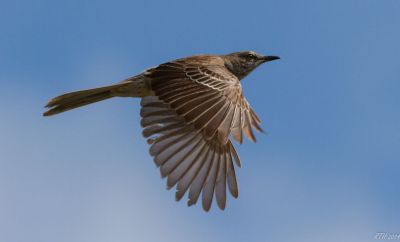- Mimus gundlachii
Identification
Mostly shades of brownish gray, underside paler. Rear flanks are variably striped with black in adult, while juveniles in addition show spotting on undersides. Shows a distinct pale supercilium and dark malar stripe, and two thin, pale wing bars. The central tail feathers are dark, while all other tail feathers are mostly dark with white tips; tail sometimes look graduated.
Similar species
Northern Mockingbird is slightly smaller with shorter tail, has stronger whitish wingbars and a white spot at base of primaries, more bluish-grey upperside, and is less strongly marked in malar area. It lacks stripes on flanks; juveniles (but not adult) have spots on breast. Northern Mockingbird's white outer tail feathers (visible in flight as well as from underside on the resting bird) and the white areas on the wing (only visible in flight) are both very different from Bahama Mockingbird.
Distribution
Endemic to the Caribbean (West Indies): found in Greater Antilles, Bahamas, Cuba, Turks and Caicos Islands, Jamaica.
Occurs as a vagrant to Florida
Taxonomy
Subspecies[1]
Two subspecies are recognized:
- M. g. gundlachii:
- M. g. hillii:
- Arid coastal lowlands of southern Jamaica
Habitat
Shrubby coastal areas with scattered trees, particularly small palm trees.
Behaviour
Somewhat secretive in its behavior.
Nest is cup-shaped and usually placed in a bush. Breeds February to June.
References
- Clements, JF. 2008. The Clements Checklist of Birds of the World. 6th ed., with updates to December 2008. Ithaca: Cornell Univ. Press. ISBN 978-0801445019.
- Avibase
- Raffaele et al. 1998. Birds of the West Indies. Christopher Helm, London. ISBN 0713649054
- Arthur Grosset
Recommended Citation
- BirdForum Opus contributors. (2025) Bahama Mockingbird. In: BirdForum, the forum for wild birds and birding. Retrieved 15 May 2025 from https://www.birdforum.net/opus/Bahama_Mockingbird
External Links
GSearch checked for 2020 platform.






